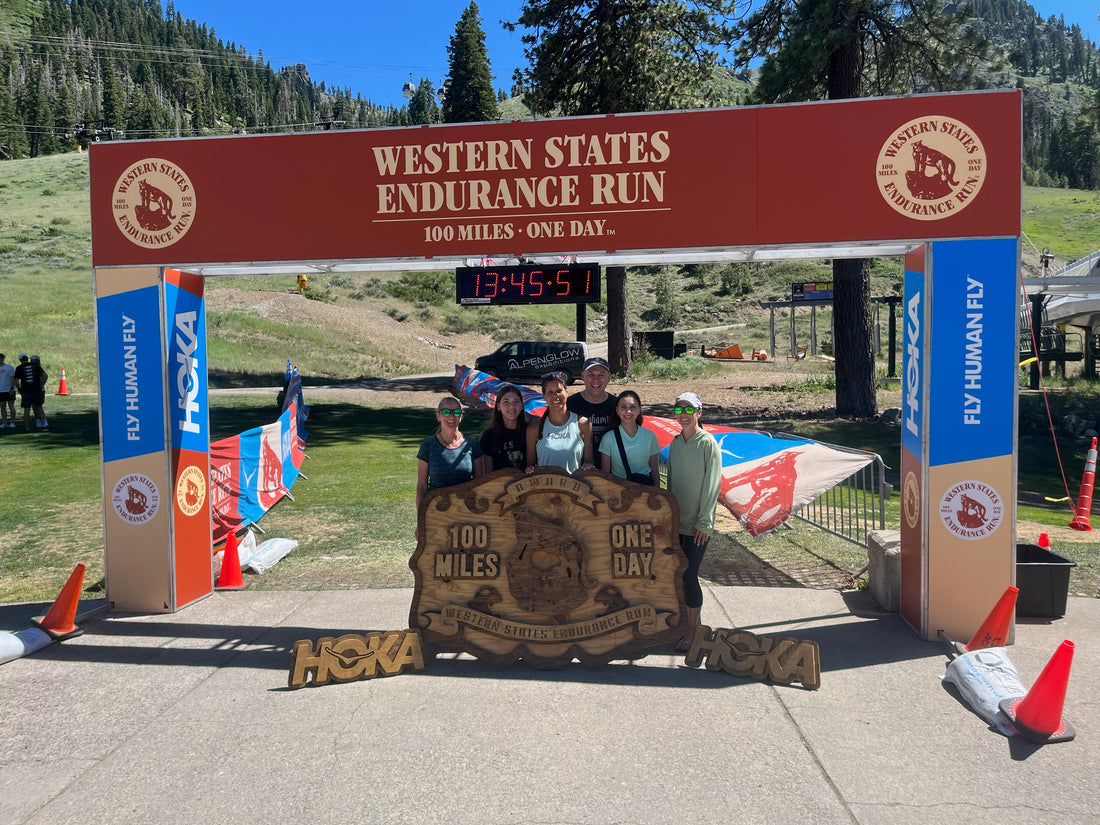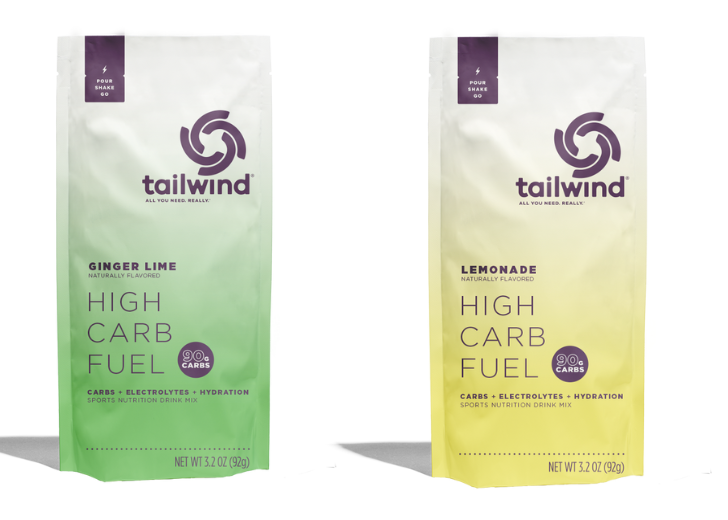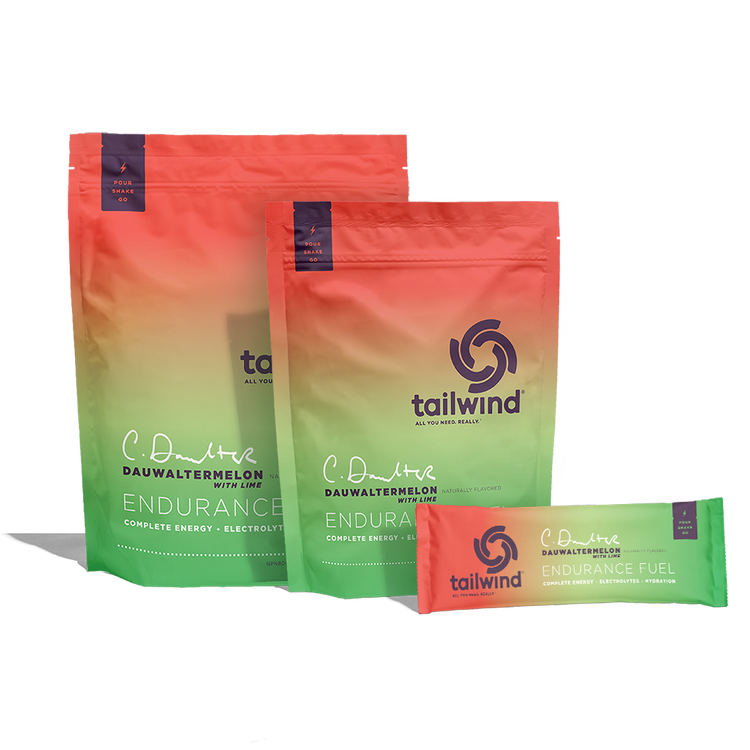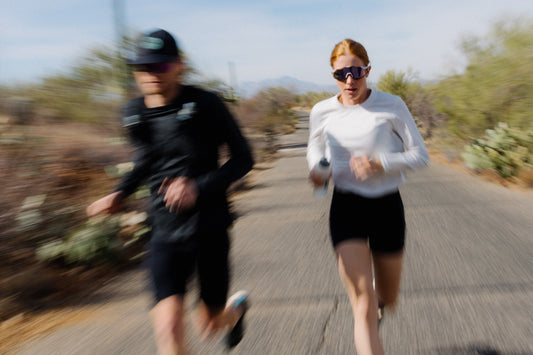Five Things I Learned From Training for Western States
0 Comments
My journey to Western States first began in 2021, about the same time I ran my first self-supported ultramarathon. This was during the pandemic, when I decided to run self supported ultras to avoid the potential cancellation of a race, and when the names “Western States” and “Courtney Dauwalter” became synonymous with anything ultrarunning for me. Each year, I have continued to become stronger, and maybe just a little wiser. But this year I found myself struggling through overuse and degenerative injuries while training for the biggest race of my life. I’ve learned a lot about life and about myself this spring, including how to maintain focus when you are drowning in uncertainty.
Five things that training for Western States has taught me:
- Training and progress may not be linear.
- Be willing to experiment with shoes and don’t underestimate their influence.
- Do not ignore strength and flexibility.
- Dialing in your nutrition is just as critical as hitting all the workouts in your training plan.
- “If you fall off a horse, you get back on. I am not a quitter.” ~Olivia Wilde
Training and progress may not be linear.
Well, the last few years were pretty linear anyway. Each spring I’d begin ramping up mileage for a late spring 50K, followed by early summer 50-milers like Cayuga Trails, followed by Twisted Branch and Virgil Crest later in the season. I love putting in the work and it’s always amazing to reap the rewards of hard training.
I had the same hopes and expectations for 2024, especially with a Western States registration, but this year has been anything but linear. A burning ache and stiffness in my left peroneal tendon that surfaced during a snowy trail run in January was accompanied by symptoms of posterior tibial tendonitis in my left ankle and tarsal tunnel syndrome in my left lower leg and medial heel by March. Conventional physical therapies, such as calf raises and banded inversions, eversions, dorsiflexion, and plantarflexion only aggravated my peroneal tendon, and compression sleeves set my posterior tibial nerve on fire. As a result, I was left to experiment to find relief, ultimately leading me to returning to zero drop shoes, a rigorous regimen of hot vinyasa yoga 4-5 days each week, regular use of a TENS machine, and the acceptance I finally found on my mat that I might not be healthy enough to run Western States this year…and should that be the case, that everything would still be alright. I would continue to work hard and troubleshoot my conditions, and it was a very scary time for me, but that acceptance was critical for my mental health.
Though I had to withdraw from the Hyner 50K in early April so I wouldn’t rush my recovery, by late April I was back to running 18-20 mile long runs, and felt as though I was back on track with my training for Western States. Then on May 6, I twisted my right ankle just under 10 miles into a 26 mile trail run, and launched. When I came to a stop, I was lying on my left side and recall reaching back to touch my throbbing right ankle. While I can’t recall whether I thought or said aloud the words “Ouch, ouch, ouch,” I knew that I had done some damage. But I also knew that I had always finished my runs after suffering an ankle sprain, so after assessing the damage, I began to hobble, and then I began to run. I would continue for more than 8 miles but after running out of fluids around mile 18, I was finding it increasingly difficult to run, and so I made the decision to stop. My experience with this ankle sprain has been significant, and I share more details of my recovery in another section below.
I’ve learned that it’s important to recognize that not all training in all seasons will be linear. Our bodies may wear down from time to time, whether that stems from nutritional deficits, a lack of strength and flexibility, acute injury, or overloading of muscles and connective tissues. But these anomalies do not care about your Ultrasignup. If we push our bodies too hard without adequate recovery, or ignore strength and flexibility for too long, ultimately some muscle, tendon, or ligament may give out, and then we’ll finally be forced to listen. But even in our darkest hours, when we fear losing everything we’ve worked for, it’s important to not give up and to continue working. Learn the lesson, do better, but never lose sight of the goal.
Be willing to experiment with shoes and don’t underestimate their influence.
Shoes are not a guarantee of success or failure, and a change of shoes is not guaranteed to cure an injury or niggle. But ever so often, they do. While always working to treat and rehabilitate the condition through corrective exercises, I have changed shoe models (decreasing the heel-to-toe drop) to accommodate IT band syndrome, and I have also changed shoe models (increasing the heel-to-toe drop) to accommodate Achilles tendinosis. And more recently, I eliminated heel-to-toe drop completely, returning to zero drop shoes as part of my approach to treat peroneal tendonitis, posterior tibial tendonitis, and tarsal tunnel syndrome, all simultaneously raging in my left foot, ankle, and heel this past spring.
Shoes are a very personal part of our gear, as we log mile after mile over sometimes questionable terrain wearing our favorite models. So many of us are loyal to a particular brand, because their shoes have worked so well for us over so many miles. But our running and our bodies are dynamic…our bodies change, we may sustain an injury or two, and suddenly our feet or legs can no longer function as well as before, while wearing our favorites. It can be a tough decision to swap out your favorite model or even brand for an alternative shoe, especially as you recall all the successful training miles and races run in your previous pair. But in my experience, I have found that staying with the old favorite may slow or prevent healing, and sometimes you are forced to make this adjustment, however stressful or uncertain it may feel at the time.
Also, it is critical to also consider the shoes that you are wearing when you are not running. We spend many hours in those shoes…most of the hours we are not running, sleeping, or showering. For me, these days my medial heel does not always respond well to heel cups or arch supports, so time spent in my beloved Birkenstocks is limited. And metatarsal pain in my right foot last fall was the start of my journey out of tight shoes. I also have bunions on each foot, sometimes necessitating a wider toe box, even for trips to the grocery store.
Do not ignore strength and flexibility.
The first twinges in my left medial heel may have begun as early as December 2023, but in January 2024 I suffered a full flare-up of my peroneal tendon, followed by a full flare-up of my posterior tibial nerve in my medial heel, in a bout of tarsal tunnel syndrome. Stiffness, ache, burning, pins and needles all plagued me, day and night.
Perhaps it was intuition that led me back to a yoga studio. Though my experience with yoga spans almost three decades, I had long sworn it off because as a runner, I was simply “too tight” in my own mind, and as a result I gave it up, rather than adjust my expectations. Perhaps it was intuition, perhaps it was me being forced to give up any and all expectations… But I sat down on my old grad school yoga mat in the studio on that first day, lost and broken. My body was slowly failing me…or was it the other way around? Had I failed to come through for my body, the one that carried me through 65 miles at Twisted Branch the previous fall and 50 miles at Virgil Crest the fall before. This was a body that ran, and ran, and ran some more. Yet now some connective tissues were degenerating, leaving me humbled and without expectations. But an open mind with zero expectations would absolutely transform my body and my mind, in the weeks and months to come.
For me, strength work has come in the form of remaining in challenging asanas for multiple seconds that feel like minutes, whereas for others strengthening may come in the form of weight lifting, plyometrics, or deadlifting. Regardless, I now recognize the importance of spending a couple of hours each week lifting, pushing, or pulling heavy things (or ourselves), to provide an opportunity for muscles, joints, and connective tissues to strengthen while recovering from all the running we love so much. I also believe that maintaining some flexibility is important because our muscles and joints are all connected. Tight hip flexors may result in a low backache and tight quads may cause knee pain. Staying flexible will allow your muscles to function freely as they need to, without pulling on another part of the body, resulting in pain. Flexible connective tissues may also be less likely to tear. And quality of life is so much better.
Dialing in your nutrition is just as critical as hitting all the workouts in your training plan.
Since running my very first self-supported 50K, I’ve fueled my training runs and races exclusively with Tailwind Nutrition. With its combination of calories, carbohydrates, and electrolytes, Tailwind has worked well for me, allowing me to continue for many hours without bonking or stomach issues. Because I have done so well fueling with Tailwind, I have not put much effort into experimenting and testing solid foods during training or racing.
But, feeling rushed in many races, I often pour an entire stick of Tailwind into a 20-ounce soft flask, resulting in a mixture that is slightly more concentrated than I’m used to, which causes me to crave water later on. In an effort to mitigate this during the Cayuga Trails 50-miler at the beginning of June, I simply poured “less” than the full Tailwind stick into the flask when I refilled my flasks 18 miles into the race, but the result was a dilute mixture. During my next refill, I attempted to pour a little more but still ended up with a dilute mixture. My stomach became less interested and I could not find any watermelon at the aid stations. The strawberries I ate were not agreeing with me and because I had not practiced with even simple foods, such as chips and gummies, I was afraid to try them on race day. So in the end, I was drinking mostly water and not taking in calories or electrolytes. I now understand that I had remained euhydrated (puffy arms and hands) but had become hyponatremic (queasiness), meaning something as simple as a salt chew or salty potato chips could potentially have saved my race (Koop, Malcolm, and Rutberg, 2021).
But dropping out of Cayuga Trails due to nutrition issues forced me to re-examine and overhaul my approach to nutrition, and I’ve spent the last two training weeks testing different foods, including caffeinated gummies, a protein bar, gluten-free pretzels, fruit gummies, potato chips, Coke, and squeezable applesauce. Some worked well while others did not, and now I have a few additional foods I can include in my race-day meal plan. And having this new knowledge gives me more confidence. You can have all the fitness in the world going into a race, but if your nutrition isn’t dialed in properly, you won’t race to your full potential.
“If you fall off a horse, you get back on. I am not a quitter.” ~Olivia Wilde
After several weeks of overhauling my running, including incorporating a hot vinyasa yoga practice 4-5 days a week, a shoe change, and physical therapy, by late April I was feeling significantly better and I was able to begin ramping up my weekly mileage. I had already completed long runs of 18 and 20 miles, and set out one Monday in early May to run a trail marathon. I’m still not exactly sure how my ankle twisted the way it did but just under 10 miles into my training run, I launched myself and came to rest on my left side, my right ankle throbbing. Thankfully, all my ankle sprains have been relatively mild, and perhaps out of denial, I stood up and proceeded to run another 8 miles. As I returned to my car to refill my soft flasks, I made the decision to stop, and I would understand later that I had suffered a high ankle sprain.
I tried not to wallow in too much disappointment, and my mindset quickly shifted from one of training to one of rehabilitation. My symptoms suggested that my high ankle sprain had been mild, and because I had remained weight-bearing since the onset, I began loading my ankle and rehabilitating the day after my injury. I attended my vinyasa class and modified my movements and asanas to accommodate a stiff and swollen ankle. As it turns out, yoga would be instrumental in restrengthening through balancing and weight-bearing, as well as helping me regain range of motion and proprioception, and I quickly saw improvements. I also began toeing the alphabet to start regaining range of motion. Slow walks around my hilly neighborhood for the first few days soon gave way to hikes on my trails by the end of the week and into the weekend. A few days after the injury, I began to perform ankle inversions, eversions, dorsiflexion, and plantarflexion, first unbanded, then progressively working through bands of increasing stiffness. I used the TENS machine to help heal and taped my ankle with KT tape and rigid tape 24 hours a day.
In the second week, I left behind the steep trails for the flat rail trail, where I began to alternate running and walking…for one day. My ankle was responding so well to all therapies that when I returned the second day, I ran 4 miles pain-free. I continued running each day after that, restrengthening my ankle as I gradually rebuilt mileage and returned to the trails. I believe that loading and rehabilitating my ankle immediately following my injury is how I was able to return to running as quickly as I did. While initially my ankle remained taped day and night, I now only tape my ankle when trail running, to protect it in case I accidentally roll it. It takes 8-10 weeks for ankle strengthening exercises to become fully effective, and sprained ankles can remain susceptible to respraining for 6-12 months after the initial injury, so my ankle will remain taped for trail runs through the rest of the season (Brukner, 2014).
I got back on the horse because I’m not a quitter.
Final thoughts…
As my ankle continued to heal and I could begin to process what happened on May 6, I was finally able to describe the feeling that had come over me in those moments when I was lying on the ground in disbelief: betrayal. I had felt as though fate and the universe had somehow betrayed me. After so many weeks of rehabilitation, I was not only healing, but once again running the big miles. And now this. But why would they betray me, and had they really? I’ve spent more time reflecting on everything and I believe now, as Katie Arnold describes her experience of breaking her leg in her book Brief Flashings in the Phenomenal World, it was simply an accident. Things happen. But it was an opportunity to start over.
While I have always tried to remain humble, in spite of my successes, my experience working through one degenerative condition after another, all while training for what will be the biggest race of my life, literally brought me to my knees and forced me to re-examine myself. It also taught me a new level of humility. We are only as good at our sport, as we are healthy. Regardless of how fit and accomplished we may be in one moment, we can lose it all in an instant. Always remain humble, don’t boast, and never take any of this for granted.
References:
Arnold, K., 2024, Brief Flashings in the Phenomenal World, Parallax Press: 208p.
Brukner, P., 2011, Brukner & Khan's Clinical Sports Medicine, McGraw-Hill: 1296p.
Koop, J., Malcolm, C., and Rutberg, J., 2021, Training Essentials for Ultrarunning, 2nd ed.: Koop Endurance Services, LLC, 522p.
Photo and Blog by Kuwanna Dyer-Pietras





